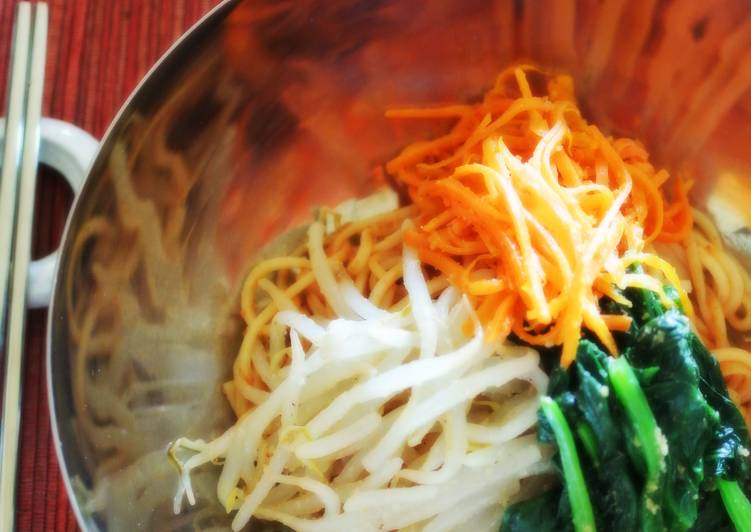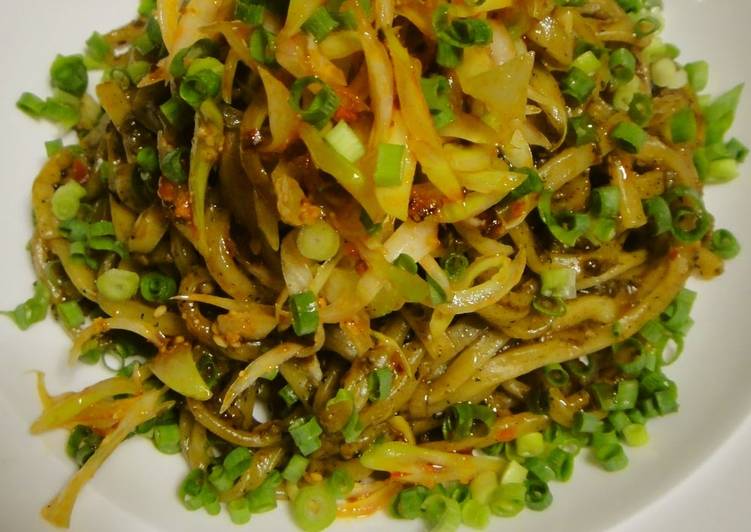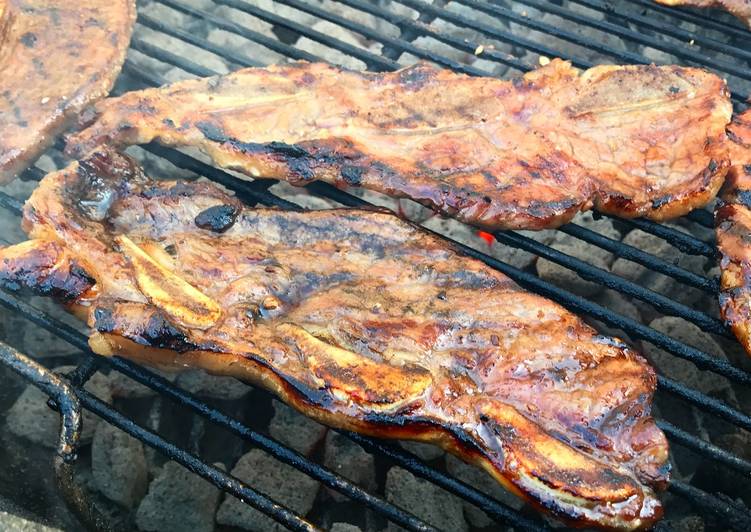
Hey everyone, it’s Brad, welcome to our recipe page. Today, I will show you a way to make a special dish, bibimbap noodles with vegetable namul and all-purpose korean sauce. One of my favorites food recipes. This time, I’m gonna make it a little bit tasty. This is gonna smell and look delicious.
Carrot, eggs, fernbrake, garlic, ground beef, hot pepper paste, rice, sesame oil, sesame seeds, shiitake mushrooms, soy sauce, soybean sprouts, spinach, vegetable oil, zucchini. Bibimbap simply translates to "mixed rice with meat and assorted vegetables". Browse my other Korean recipes from here.
Bibimbap Noodles With Vegetable Namul and All-Purpose Korean Sauce is one of the most favored of recent trending foods in the world. It is easy, it is quick, it tastes delicious. It’s enjoyed by millions daily. They’re fine and they look wonderful. Bibimbap Noodles With Vegetable Namul and All-Purpose Korean Sauce is something which I’ve loved my entire life.
To get started with this particular recipe, we have to prepare a few components. You can cook bibimbap noodles with vegetable namul and all-purpose korean sauce using 30 ingredients and 17 steps. Here is how you can achieve that.
The ingredients needed to make Bibimbap Noodles With Vegetable Namul and All-Purpose Korean Sauce:
- Prepare Spinach Namul:
- Get 1 bunch ・Spinach (170 grams to 200 grams)
- Get 1 1/2 2 teaspoons ・Soy Sauce Dashi (Mentsuyu - 2x concentrated)
- Prepare 1 dash ・Garlic
- Prepare 1 tbsp ・Sesame oil
- Make ready 1 tbsp ・Ground white sesame seeds
- Make ready Bean Sprout Namul:
- Get 1 tbsp ・Ground white sesame seeds
- Get 1 as much as you want Noodles (Cold Korean Noodles, Hiyamugi Noodles, Soumen Noodles)
- Get 1 bag ・Bean Sprouts
- Take 1 tbsp ・Sesame oil
- Get 1/2 tsp ・Salt
- Take 1 ・Garlic (a small amount, as desired)
- Get 1 tbsp ・Ground white sesame seeds
- Take 1 as much as you want Noodles (Cold Korean Noodles, Hiyamugi Noodles, Soumen Noodles)
- Make ready All-Purpose Sauce:
- Take 6 tbsp ・ Gochujang (108 grams)
- Make ready 5 tbsp ・Sugar (45 grams)
- Prepare 5 tbsp ・Soy sauce (90 grams)
- Get 5 tbsp ・Vinegar (75 grams)
- Make ready 1 clove ・Grated garlic
- Take 2 tbsp ・Sesame oil (24 grams)
- Prepare 5 tbsp ・Ground white sesame seeds (50 grams)
- Prepare 2 tbsp ・Sesame oil
- Prepare 5 tbsp ・Ground white sesame seeds
- Prepare Carrot Namul:
- Take 1 ・Carrot
- Get 1 1/2 tbsp ・Sesame oil
- Make ready 1 dash each ・ Salt ・ Grated Garlic
- Prepare 2/3 tbsp ・Ground white sesame seeds
Authentic and traditional Bibimbap Korean bibimbap is basically a salad of rice, different flavors and textures of vegetables and meats Instead of bellflower roots and spinach, you can also make these: radish namul and perilla namul. Bibimbap - it reminds me of Korean Airlines' delicious in-flight meal. The secret to making great Topped with a variety of seasoned vegetables (referred to as namul). Then a main protein like Today, our bibimbap toppings will be all vegetables!
Instructions to make Bibimbap Noodles With Vegetable Namul and All-Purpose Korean Sauce:
- To make the sauce, combine the ingredients in order in a storage container, stirring continuously. This will keep in the refrigerator for a month or more. - Depending on the brand of the gochujang, you may need to decrease the amount of sugar.
- Cut the carrot into half lengthwise. I used a wide julienne slicer to cut them.
- Heat the frying pan on medium heat, add the sesame oil and the carrot, and cook as if cooking kinpira. When the carrot becomes tender, stir in the salt and garlic, stop the heat, and sprinkle with the sesame seeds.
- Boil the bean sprouts in plenty of hot water for 50 - 60 seconds. When the water comes to a boil again, drain the bean sprouts in a colander and place in a bowl. Stir in the sesame oil and other flavoring ingredients while the bean sprouts are still hot.
- Blanch the spinach and cool it in ice water. Wring out the excess moisture and cut into 4 cm pieces. Combine with the other flavoring ingredients.
- Cook the noodles, chill in ice water, and drain the water completely. Combine the noodles and the sauce (1 serving = 3 - 4 tablespoon) in a bowl. Arrange the various namul on top.
- Namul servings prepared: Carrot & Spinach Namul = 3 servings; Bean Sprout Namul = 4 servings.
- This recipe uses the three types of namul made here. "Stone-Roasted Bibimbap"
- I used the all-purpose Korean sauce to make the recipe "Impromptu Cucumber Kimchi"
- You can use the all-purpose Korean sauce in this recipe too. "Dakhanmari Korean-Style Broth Hot Pot"
- "Slightly Spicy Squid and Soft-Boiled Egg"
- "Salmon & Onion Marinated with All-Purpose Korean Sauce" - "Seared Skipjack Bonito & Onion Marinated with All-Purpose Korean Sauce"
- "Simple Mulukhiyah Soup with All-Purpose Korean Sauce"
- "Korean-Style Simmered Daikon Radish with Soboro"
- "South Korean Style Cold Tofu with All-Purpose Korean Sauce"
- "Chilled Microwave-Steamed Eggplant"
- "Blended Japanese and Korean Style Bibimbap Noodles"
But feel free to include a protein of choice - like. Bibimbap is a traditional Korean dish comprised of rice, a mixture of vegetables, an egg, and sometimes meat, often served in a hot stone bowl. It's typically served with sauce, my favorite being Gochujang. A traditional Korean dish of rice, vegetables, fiery chile paste, and browned slices of beef is topped with a Along with kimchi, bibimbap takes its place among the favored foods in Korean cuisine. I use: bean sprouts, shredded carrot that I mix with the thicker soy sauce, chicken tossed in the same.
So that is going to wrap it up with this exceptional food bibimbap noodles with vegetable namul and all-purpose korean sauce recipe. Thanks so much for your time. I am confident that you can make this at home. There is gonna be interesting food at home recipes coming up. Don’t forget to bookmark this page in your browser, and share it to your loved ones, colleague and friends. Thank you for reading. Go on get cooking!


